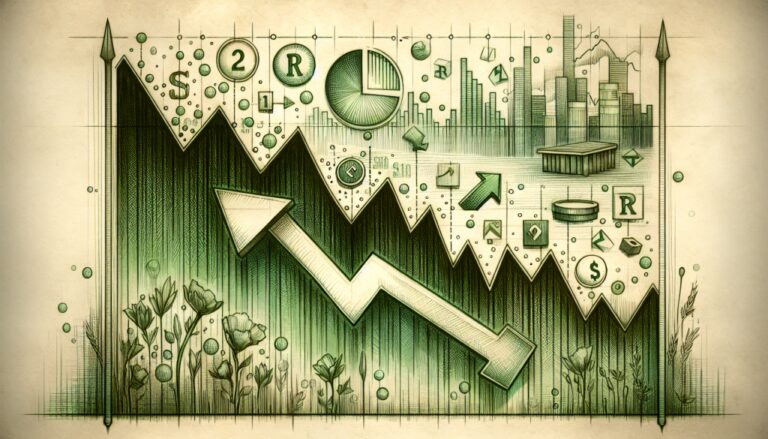
Shares have skilled a outstanding rally just lately, with a 16% improve in simply three months. This surge has been fueled by the expectation that the Federal Reserve (the Fed) will reduce rates of interest. However do charge cuts really profit the market? On this article, we are going to discover historic information to evaluate the affect of rate of interest cuts on the inventory market and supply insights into the potential penalties for buyers with a $1 million inventory portfolio. We will even focus on how bonds carry out throughout these intervals and why it could be a great time to diversify your funding technique.
Historic Efficiency of Shares In the course of the Fed’s Price Cuts
Buyers usually categorical enthusiasm for potential charge cuts by the Fed, anticipating that decrease rates of interest will stimulate financial development. Nonetheless, an evaluation of historic information means that rate of interest cuts might have a extra difficult relationship with the inventory market efficiency.
Over the last 9 instances, the Federal Reserve paused elevating rates of interest after which proceeded with charge cuts, the transitional pause interval normally witnessed a spike in inventory costs. Apparently, although, as soon as the precise charge cuts began, the market wasn’t type to buyers.
On common, following the graduation of rate of interest cuts, the inventory market has skilled a 23% decline in value. For these with a $1 million inventory portfolio, this might imply a worrying discount to $750,000. This means that buyers would possibly must train warning and think about diversification methods in anticipation of potential charge cuts.
Why Do Curiosity Price Cuts Have an effect on Shares Negatively?
One would possibly assume that reducing rates of interest would routinely profit the inventory market, because it reduces the price of borrowing and encourages spending. Nonetheless, the connection between charge cuts and inventory efficiency is extra nuanced. When the Fed cuts rates of interest, it usually makes an attempt to counter an financial slowdown or stop a recession. In these conditions, the underlying financial situations might outweigh any potential advantages of decrease rates of interest.
Moreover, lowered rates of interest normally imply that the returns on protected investments like cash market accounts or certificates of deposit turn into much less interesting to buyers. This results in an inflow of cash into the inventory market, which may end up in overvalued stocks and, in the end, inventory market corrections.
Bonds as an Funding Different
Bonds are likely to carry out effectively throughout rate of interest cuts attributable to an inverse relationship between bond costs and rates of interest. As rates of interest lower, current bonds with fastened rates of interest turn into extra engaging to buyers, growing costs.
Investing in bonds throughout rate of interest cuts can present a worthwhile hedge towards potential inventory market declines. Allocating a portion of your funding portfolio to bonds might shield your wealth from the adversarial results of charge cuts, guaranteeing you preserve a balanced and diversified funding technique.
Conclusion
Though the inventory market has been rallying in anticipation of potential rate of interest cuts by the Fed, historic information signifies that buyers would possibly must brace themselves for a doable downturn after the graduation of those charge cuts. Inventory portfolios have traditionally skilled important declines following charge cuts, usually round 23%. To safeguard your investments throughout these intervals, it could be smart to diversify your portfolio by together with bonds, which have a tendency to extend in value when rates of interest are falling.
In conclusion, whereas it could be tempting to experience the wave of inventory market pleasure within the face of potential rate of interest cuts, it’s important to base your funding choices on historic information and tendencies to make sure long-term financial stability. By adopting a diversified strategy that features each stocks and bonds, you may shield your wealth from the potential penalties of charge cuts and make sure you proceed constructing a resilient and profitable funding portfolio.
Ceaselessly Requested Questions
Do rate of interest cuts profit the inventory market?
Whereas decrease rates of interest can stimulate financial development, they could not at all times lead to constructive inventory market efficiency. Historic information present stocks usually improve through the transitional pause interval earlier than charge cuts start however then expertise a decline as soon as charge cuts begin, averaging a 23% loss in value.
Why do rate of interest cuts generally negatively have an effect on stocks?
When the Federal Reserve lowers rates of interest, it usually does so to counter an financial slowdown or stop a recession. In these conditions, the underlying financial situations might outweigh any potential advantages of decrease rates of interest. Lowered rates of interest can even result in overvalued stocks and inventory market corrections.
How do bonds carry out in periods of rate of interest cuts?
Bonds are likely to carry out effectively throughout rate of interest cuts attributable to an inverse relationship between bond costs and rates of interest. As rates of interest lower, current bonds with fastened rates of interest turn into extra engaging to buyers, inflicting their costs to rise.
How can buyers shield their wealth in periods of rate of interest cuts?
To safeguard investments throughout charge cuts, it could be smart to diversify a portfolio by together with bonds, which have a tendency to extend in value when rates of interest are falling. Adopting a diversified strategy that features stocks and bonds can assist shield wealth from the potential penalties of charge cuts.
The submit How Will Price Cuts Influence Shares appeared first on Due.